

7 Essential Facts About Emotional Support Dog Harness
by Lena Park
Last updated: July 10, 2025
Verified and Approved by:
Angela Morris,
MSW, LCSW
Fact Checked

Overview
This article lovingly explores the essential facts about emotional support dog harnesses, highlighting their numerous benefits, various types, and important legal considerations. It gently emphasizes how these harnesses not only enhance safety and identification for emotional support animals but also foster smoother interactions in public spaces. By ensuring the well-being of both the animal and its owner, we recognize the growing necessity of these harnesses in the realm of mental health care, offering a compassionate understanding of their role in supporting individuals facing emotional challenges.
Introduction
In a world where mental health awareness is blossoming, emotional support animals are emerging as invaluable companions for many individuals. The rising demand for these supportive pets highlights the crucial need to ensure their well-being and effective integration into daily life. This article explores the streamlined processes for obtaining Emotional Support Animal letters, the benefits of specialized harnesses designed for these animals, and the legal considerations surrounding their use.
Have you ever wondered how these harnesses can enhance the safety and comfort of emotional support dogs? From understanding the different types available to debunking common misconceptions, you will discover essential insights that empower you as an ESA owner. With practical tips for caring for these harnesses and navigating travel regulations, this comprehensive guide aims to foster a healthier, more fulfilling bond between you and your furry friend.
Wellness Wag: Streamlined Process for Obtaining ESA Letters
At Wellness Wag, we understand that navigating mental health challenges can be incredibly tough. Many individuals struggle with feelings of isolation and anxiety, and the process of obtaining necessary support can often feel overwhelming. This is where Emotional Support Animals (ESAs) can play a transformative role in enhancing well-being.
Our process for obtaining ESA letters is designed with your needs in mind. It begins with a brief assessment to determine eligibility, ensuring that you feel supported from the very start. Following this, you will have the opportunity to engage in compassionate consultations with licensed physicians who genuinely care about your mental health needs. They will assess your situation and provide tailored guidance to help you on your journey.
Once approved, you can expect to receive your official ESA letter within 24 hours. This timely assistance is crucial, as studies show that having an emotional support animal can significantly reduce symptoms of mental health issues, enhancing both emotional resilience and physical well-being. We recognize the importance of prompt access to such letters in improving your overall mental health.
As the demand for support animals continues to grow—evidenced by a 20% annual increase in Australia—Wellness Wag remains dedicated to streamlining the ESA letter process. We are here to make it accessible and effective for those in need, ensuring that you receive the support you deserve. Remember, you are not alone in this journey; we are here to help you every step of the way.
Purpose of Emotional Support Dog Harnesses: Enhancing Comfort and Accessibility
The emotional support dog harness plays a crucial role in enhancing comfort and accessibility for both the pet and its owner. The emotional support dog harness provides supportive restraints that offer a secure fit, enabling better control during walks and reducing the risk of escape or harm.
With nearly 200,000 emotional support animals recorded in the U.S. as of 2019, there is a significant need for effective management devices that ensure the safety and well-being of these beloved companions. Moreover, many attachments, such as the emotional support dog harness, feature identification patches that communicate to the public that the dog is more than just a pet, facilitating smoother interactions in communal spaces.
A case study has highlighted the positive impact of support devices, such as the emotional support dog harness, on these individuals, showcasing how such tools can enhance comfort and confidence during outings. Emma noted that the costs associated with therapy pets can range from $20,000 to $30,000, covering training, veterinary visits, food, and care. This underscores the importance of restraints, including the emotional support dog harness, as part of the overall investment in the well-being of these cherished animals.
Current trends indicate a growing acceptance of comfort devices, reflecting a heightened awareness of their benefits. Specialists emphasize that using an emotional support dog harness not only improves the physical management of the animal but also contributes to the psychological well-being of the owner by fostering a sense of safety.
As the reliance on therapy animals continues to rise, the emotional support dog harness plays a crucial role in ensuring their successful integration into daily life. With over 4.28 million people involved in the animal-assisted workforce, the demand for such supportive tools is expected to grow, highlighting their vital role in mental health care. Additionally, understanding the legal distinctions between therapy animals and service animals is essential for navigating public spaces and safeguarding the rights of those who depend on these companions.

Legal Regulations for Emotional Support Dog Harnesses: What You Must Know
While federal regulations do not mandate that comfort animals wear an emotional support dog harness, many specialists recommend using an emotional support dog harness for easy identification. For individuals facing mental health challenges, understanding the legal landscape for Emotional Support Animals (ESAs) is crucial. The Fair Housing Act and the Air Carrier Access Act are key laws that protect the rights of ESA owners, allowing them to live and travel with their companions in various settings, provided they have the necessary documentation.
In 2025, it remains essential for ESA owners to grasp their rights under these regulations. The Fair Housing Act, for instance, guarantees that individuals with therapy animals can reside in pet-restricted accommodations. This underscores the importance of possessing valid ESA letters. Moreover, the Air Carrier Access Act facilitates the travel of ESAs on airlines, as long as the appropriate paperwork is presented.
Legal compliance is further supported by case studies that demonstrate the nationwide recognition of ESAs under federal law, granting them legal protections in housing situations. This recognition is vital for individuals facing mental health challenges, as it allows them to maintain their therapeutic relationships with their animals.
Experts also stress the importance of checking state-specific regulations concerning ESAs, as these can vary significantly. While restraints are not legally mandated, using an emotional support dog harness can serve as a helpful resource for ensuring that assistance animals are easily recognizable in public areas. This can help reduce misunderstandings and promote smoother interactions in environments where emotional support dog harnesses are present. In conclusion, although there are no strict legal obligations for using an emotional support dog harness, understanding the broader legal framework and utilizing such gear can enhance the experience for both ESA owners and the communities they engage with. Remember, you are not alone in this journey; support is available to help you navigate these challenges.
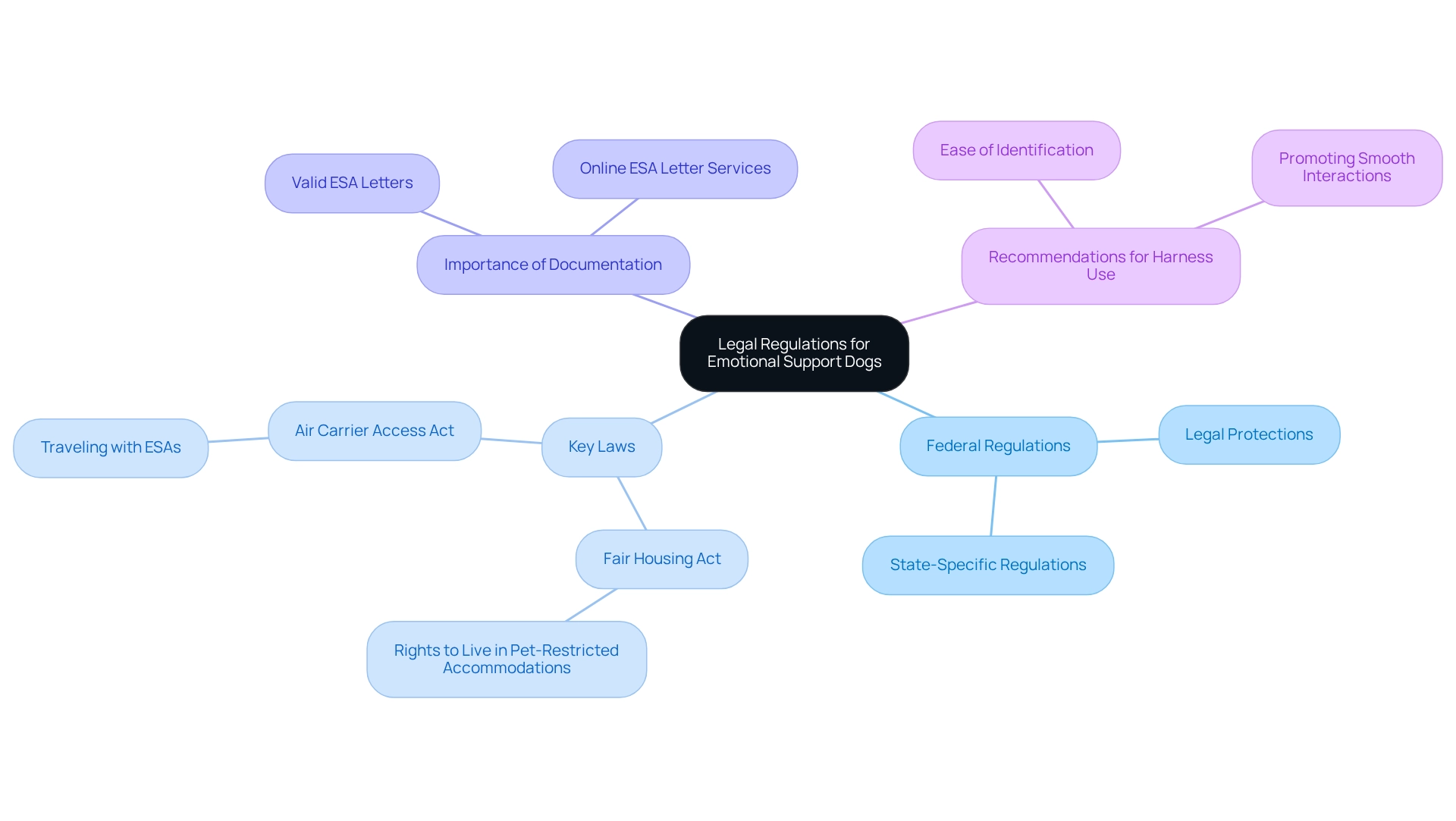
Benefits of Emotional Support Dog Harnesses: Safety and Identification
Emotional support dog harness provides crucial benefits, particularly in terms of safety and identification. These restraints are designed to prevent dogs from escaping during walks, significantly reducing the risk of incidents or lost pets. For both owners and their comfort companions, the emotional support dog harness can alleviate anxiety, creating a more secure and enjoyable experience during outings. Moreover, many of these harnesses feature labels that clearly identify the dog as a companion for emotional assistance. This identification can help avoid misunderstandings in public spaces, promoting smoother interactions with others and ensuring that the rights of ESA owners are honored.
Recent information underscores the importance of these devices, especially given the increase in incidents involving emotional support animals during air travel. With changing regulations, ESAs now face similar scrutiny as pets, leading to a rise in reported occurrences. This situation highlights the need for enhanced safety protocols, including the introduction of devices that can improve the visibility and protection of these beloved animals.
Practical examples illustrate that restraints not only bolster safety but also contribute to a more positive experience for both the pet and the owner. Veterinarians emphasize the importance of proper identification for therapy animals, noting that it can significantly affect how they are perceived in various environments. By utilizing an emotional support dog harness, owners can ensure their pets are recognized and accommodated appropriately, reinforcing the essential role these animals play in their lives.

Types of Emotional Support Dog Harnesses: Finding the Right Fit
Emotional support dog harnesses come in a variety of designs, each thoughtfully customized to meet specific needs and preferences. Among the most common types are:
- Standard Harnesses: These versatile options are perfect for everyday use, ensuring comfort and support for both the dog and the owner.
- No-Pull Devices: Designed for dogs that tend to pull on the leash, these fittings feature a front-clip design that helps prevent tugging, making walks more enjoyable and manageable.
- Tactical Gear: With added features like handles and storage compartments, tactical gear is ideal for active lifestyles, allowing owners to carry essentials while keeping their dog secure.
As we look forward to 2025, the market for emotional support dog harness equipment has seen significant growth, reflecting the diverse preferences of pet owners. Many prioritize comfort and functionality, leading to an increased demand for no-pull and tactical options. According to Wellness Wag, flexible payment options for these devices start as low as $32.25, making them accessible to a broader audience. Experts emphasize the importance of selecting a device that fits well and aligns with the dog’s behavior and activity level. As canine behavior expert Cesar Millan beautifully states, ‘Love is the key to training a dog,’ underscoring the necessity of choosing the right equipment for effective training and companionship.
As the landscape of therapeutic animals evolves, especially with the recent updates to the Air Carrier Access Act, understanding the various types of restraints available is crucial for ensuring both safety and comfort for these beloved companions. The changes in travel regulations highlight the need for proper documentation and the importance of utilizing options that support the rights of emotional support animals.
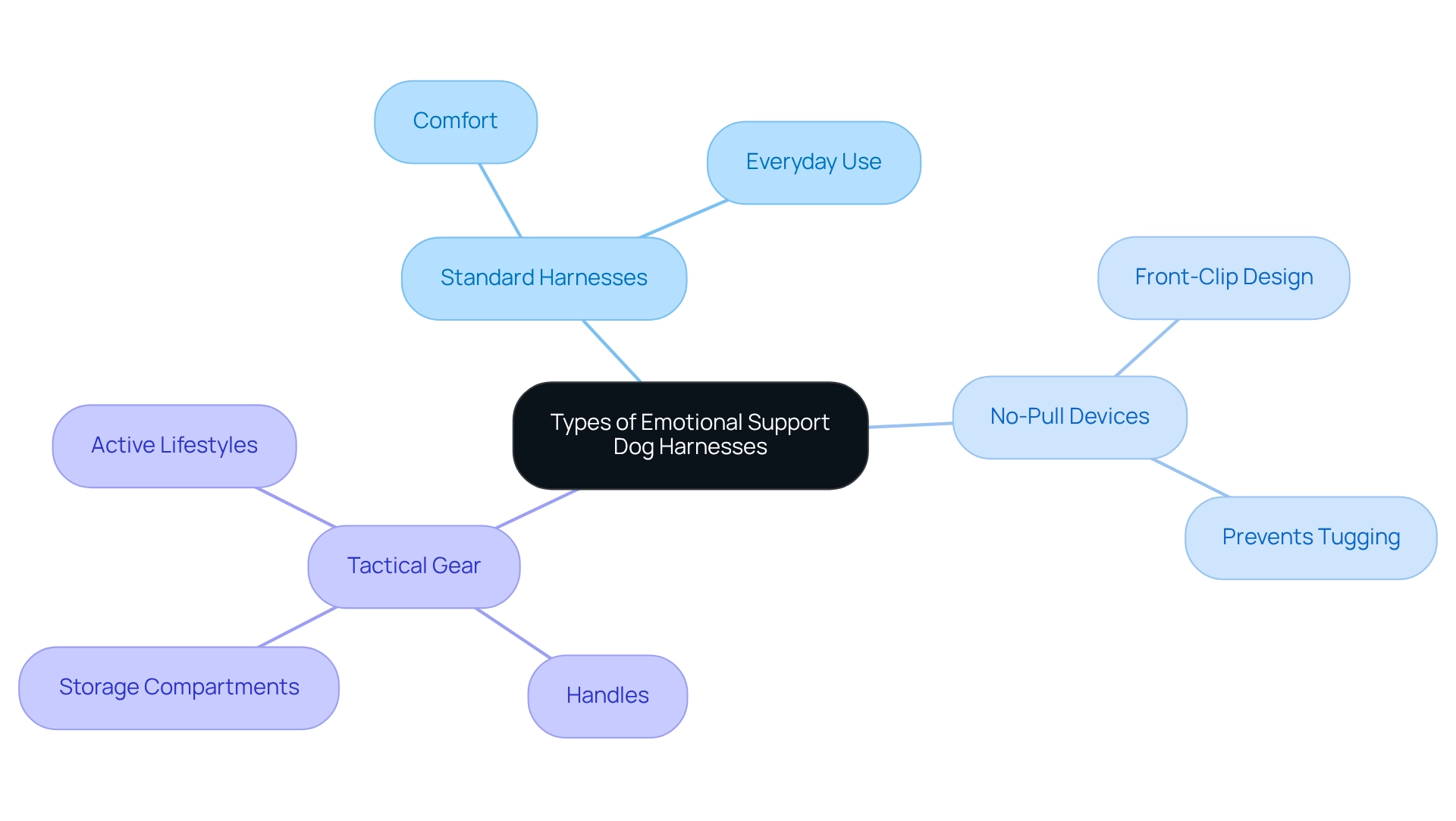
Sizing and Fitting Emotional Support Dog Harnesses: Ensuring Comfort
To ensure your beloved dog’s comfort, it’s important to measure them accurately before purchasing a restraint. Start by measuring:
- The girth around the widest part of their chest.
- The length from the nape of their neck to the base of their tail.
Many devices come with adjustable straps, allowing for a snug fit that isn’t overly tight. When properly adjusted, the device provides your dog with the freedom to move while also offering the essential support they need. Remember, your dog’s comfort is a priority, and taking these steps ensures they feel secure and cared for.
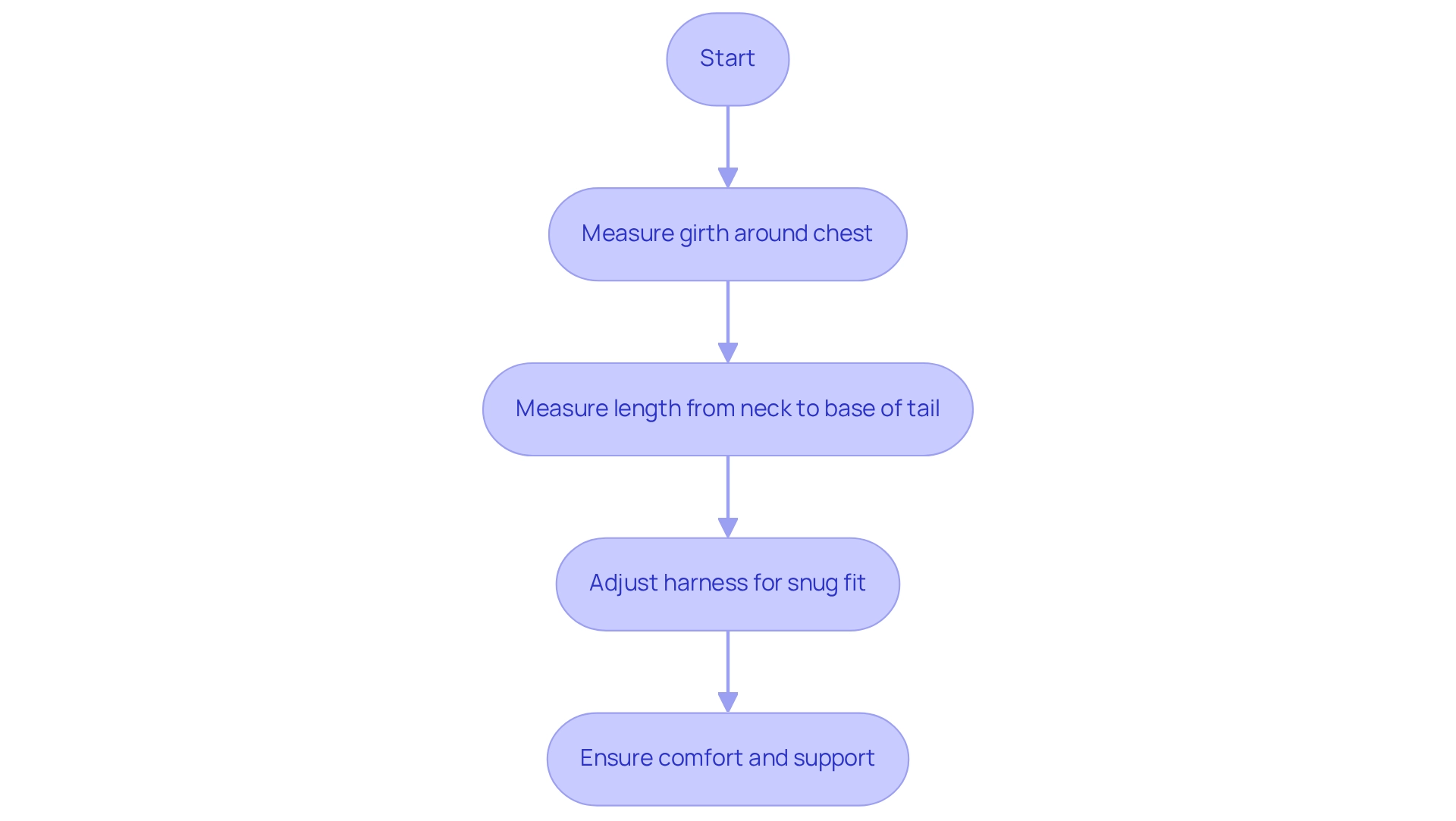
Materials and Features of Emotional Support Dog Harnesses: What to Look For
When selecting an emotional support dog harness, it’s essential to consider the materials used in its construction. Think about how the right straps, crafted from sturdy yet breathable materials like nylon or mesh, can provide not only comfort but also necessary airflow for your furry companion.
Features to consider include:
- Reflective strips for visibility
- Padded straps for added comfort
- Quick-release buckles for easy on-and-off
These thoughtful elements significantly enhance the overall safety and usability of the equipment, ensuring that both you and your dog feel secure and supported when using an emotional support dog harness.
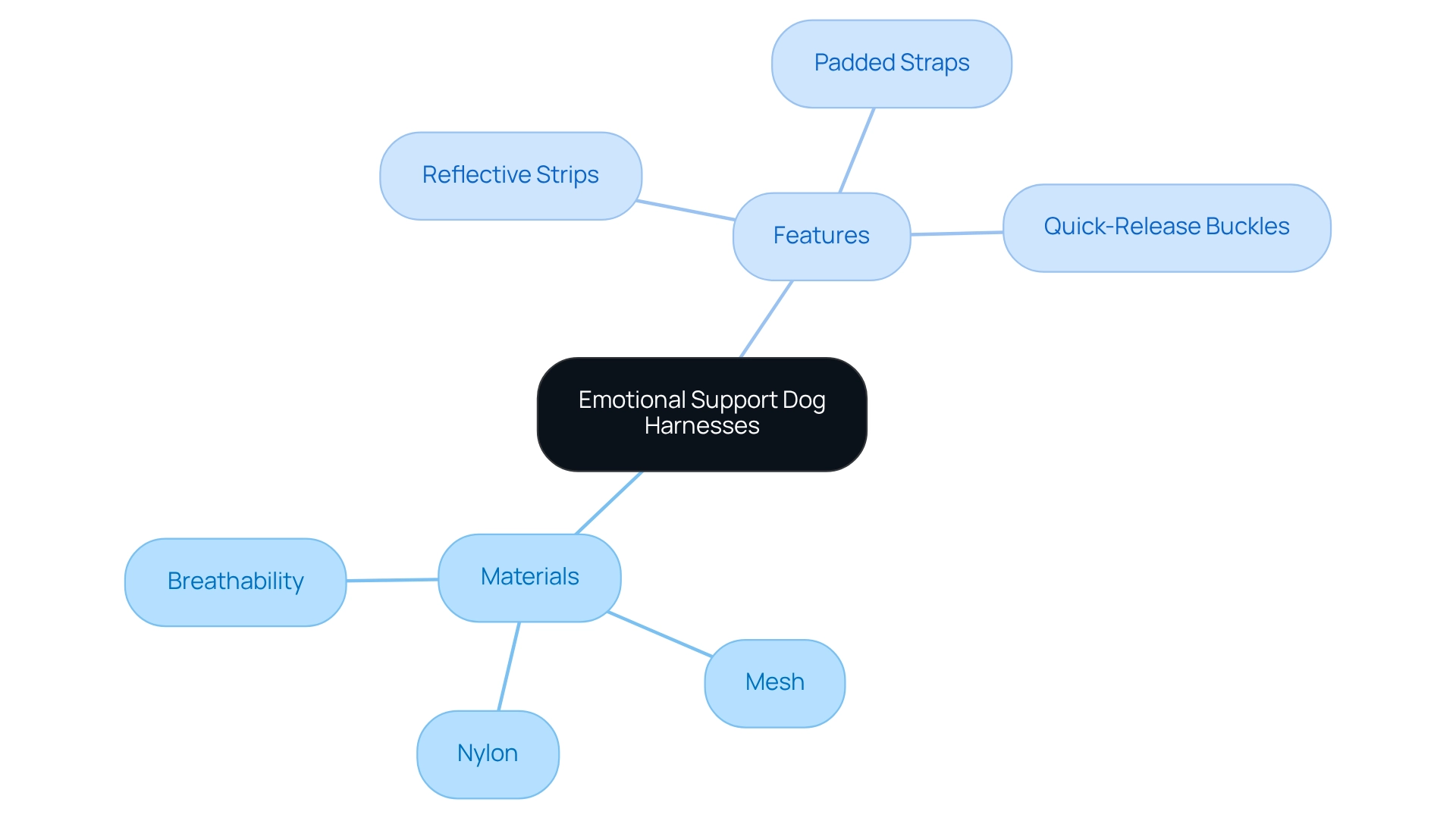
Common Misconceptions About Emotional Support Dog Harnesses: Debunking Myths
Misunderstandings about assistance dog gear are unfortunately common, leading to confusion among pet owners. Many people mistakenly believe that emotional support animals (ESAs) are required by law to wear a vest. In reality, there is no legal mandate for ESAs to don such equipment. However, using an emotional support dog harness can ease interactions in public spaces, signaling to others that the animal is there to provide assistance.
Another frequent misconception is that all support devices are interchangeable. In truth, restraints serve specific purposes and should be selected based on the unique needs of the dog and the lifestyle of the owner. For instance, some restraints are intended for training, while others prioritize comfort or safety during travel.
Statistics reveal that numerous ESA owners choose restraints to enhance their pets’ visibility and facilitate better communication with the public. Yet, misunderstandings persist, with some believing that restraints are essential for every ESA. Experts suggest that while the emotional support dog harness can be advantageous, it is not universally required. The focus should instead be on the psychological support the animal provides, rather than solely on the gear it wears.
Research has shown that therapeutic companions can significantly alleviate symptoms of mental health challenges, underscoring the importance of the bond between owner and pet over the specific equipment used. By clarifying these misconceptions, pet owners can make informed decisions about the best practices for their therapeutic animals, ensuring the well-being of both themselves and their beloved companions.
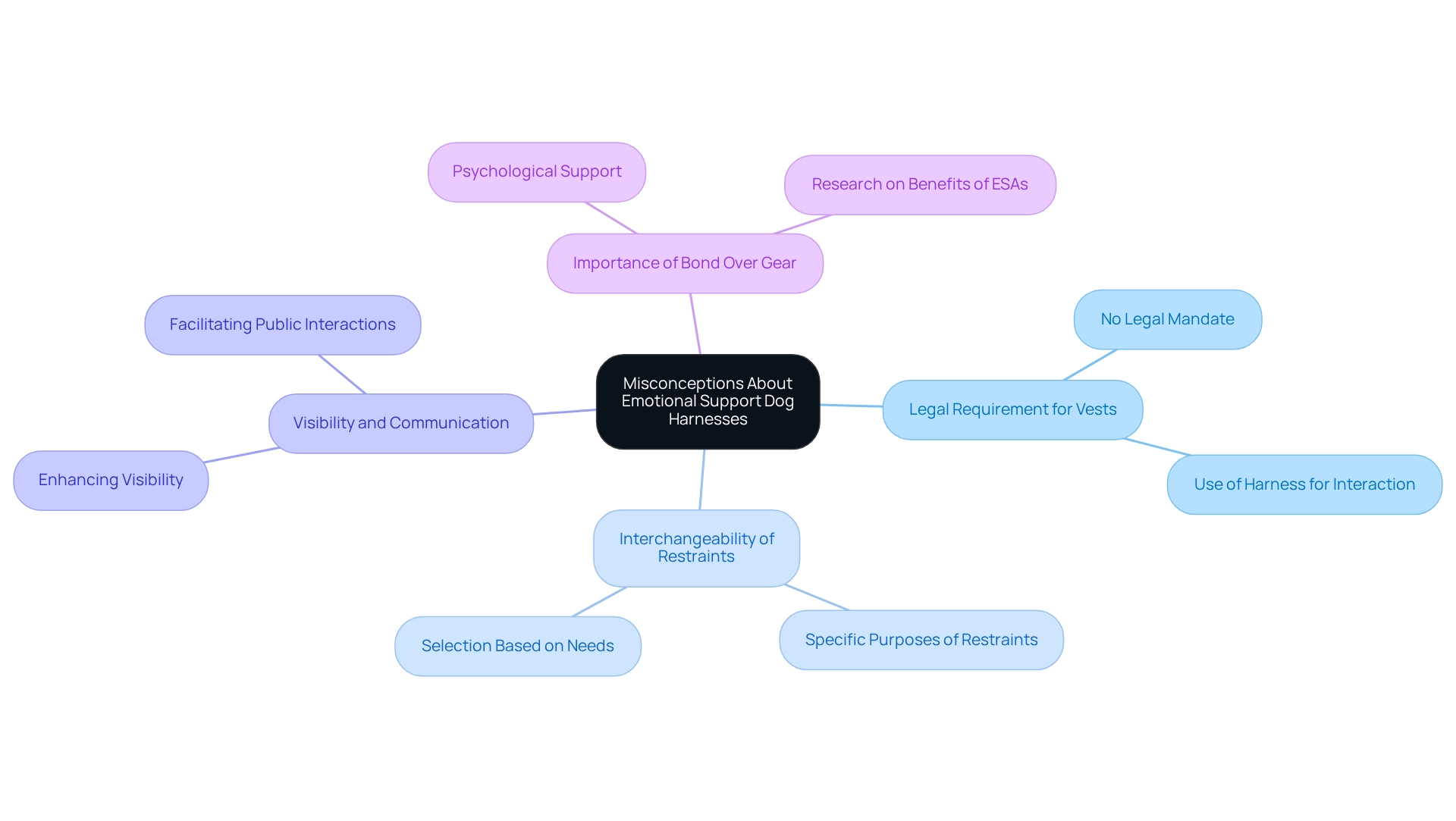
Traveling with Emotional Support Dog Harnesses: Guidelines and Tips
Traveling with a comfort dog requires thoughtful consideration to ensure both ease and compliance with airline regulations. A well-fitted and comfortable harness is essential for your dog’s well-being throughout the journey. As we look ahead to 2025, it’s important to note that airline regulations regarding therapy animals have evolved. Many airlines now require specific paperwork to verify the dog’s designation as an Emotional Support Animal (ESA). Familiarizing yourself with these policies before booking your flight is crucial to avoid any last-minute complications.
To help your dog feel secure during travel, consider bringing along a familiar blanket or toy. These comforting items can significantly reduce anxiety, especially in unfamiliar environments. It’s heartening to know that statistics reveal participants in therapy dog programs often report enhanced social interactions and decreased feelings of loneliness, underscoring the psychological benefits of having an ESA by your side.
When preparing for travel, make sure you have all necessary documentation readily accessible, including the U.S. DOT forms required by Air Canada. This preparation not only facilitates a smoother boarding process but also reinforces your rights under the Fair Housing Act and the Air Carrier Access Act. Additionally, be mindful of any pet fees that may apply based on the flight type, as well as breed restrictions for service dogs, particularly for snub-nosed breeds. Expert travel advice suggests scheduling regular stops during extended trips, allowing your dog to stretch and take care of itself, which can greatly enhance their comfort.
By following these suggestions and being attentive to your assistance dog’s needs, you can cultivate a positive travel experience that benefits both you and your furry companion. Remember, you are not alone in this journey; support is available to help you navigate these challenges with care and compassion.
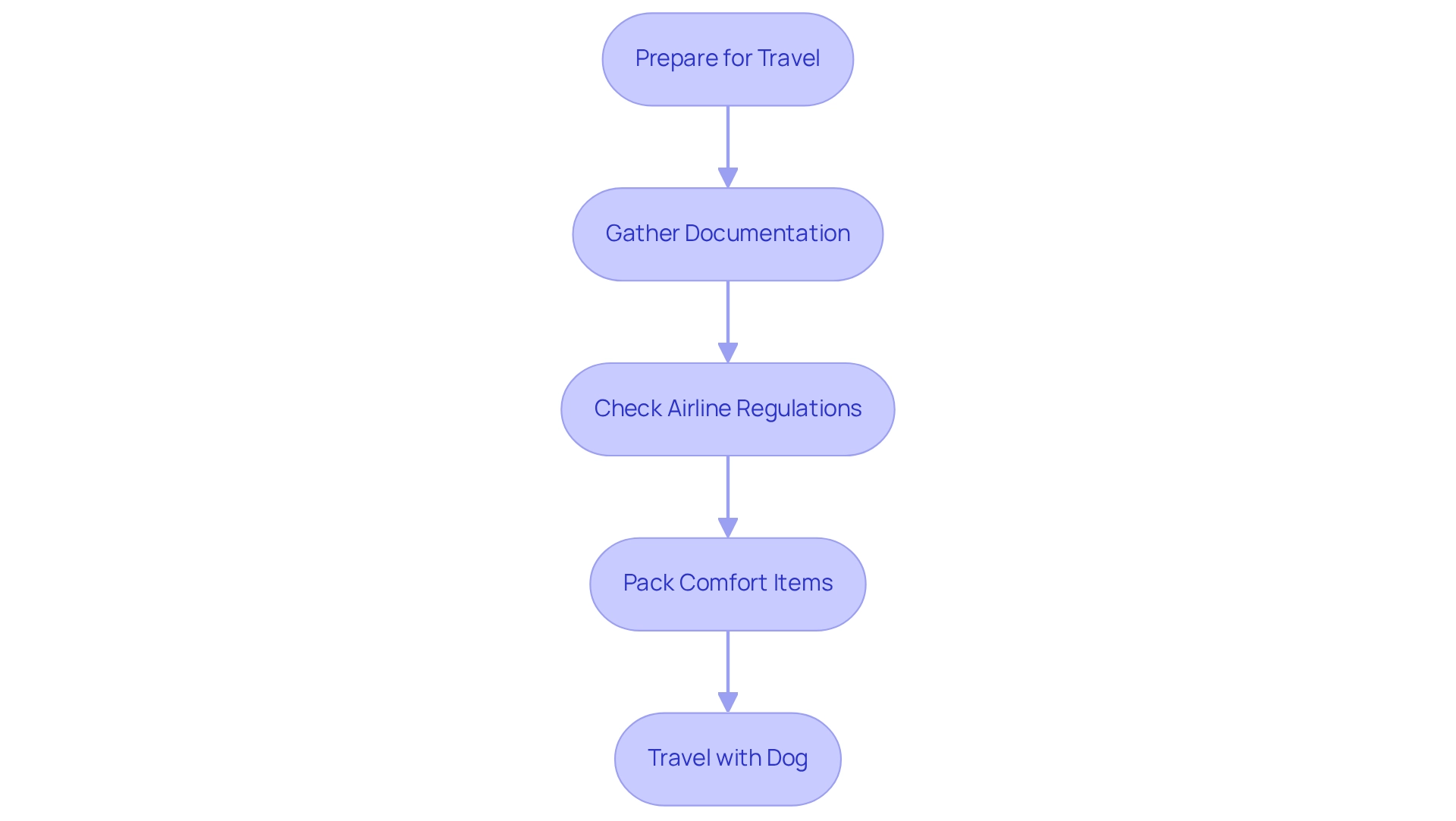
Caring for Emotional Support Dog Harnesses: Maintenance Tips
To ensure the longevity and effectiveness of your emotional support dog harness, it’s essential to regularly inspect it for any signs of wear and tear. Cleaning the equipment should follow the manufacturer’s guidelines, which typically recommend hand washing with gentle soap and allowing it to air dry. Proper storage is just as important; keeping the equipment in a cool, dry location when not in use helps prevent deterioration.
Regular upkeep not only extends the lifespan of the equipment but also ensures the safety and comfort of your emotional support dog harness for your animal. Pet care experts agree that consistent maintenance significantly enhances the longevity of the equipment, making it a worthwhile investment for both you and your furry friend.
Furthermore, research indicates that equipment made from high-quality materials can last between 1 to 3 years, depending on usage and maintenance practices. By following these professional care suggestions, you can ensure that your emotional support dog harness and other assistance dog equipment remain in peak condition, providing the essential support your beloved companion needs.
Remember, having an emotional support animal can allow you to stay in non-pet friendly hotels without incurring extra fees, making it crucial to keep your emotional support dog harness in excellent shape for travel and daily activities.
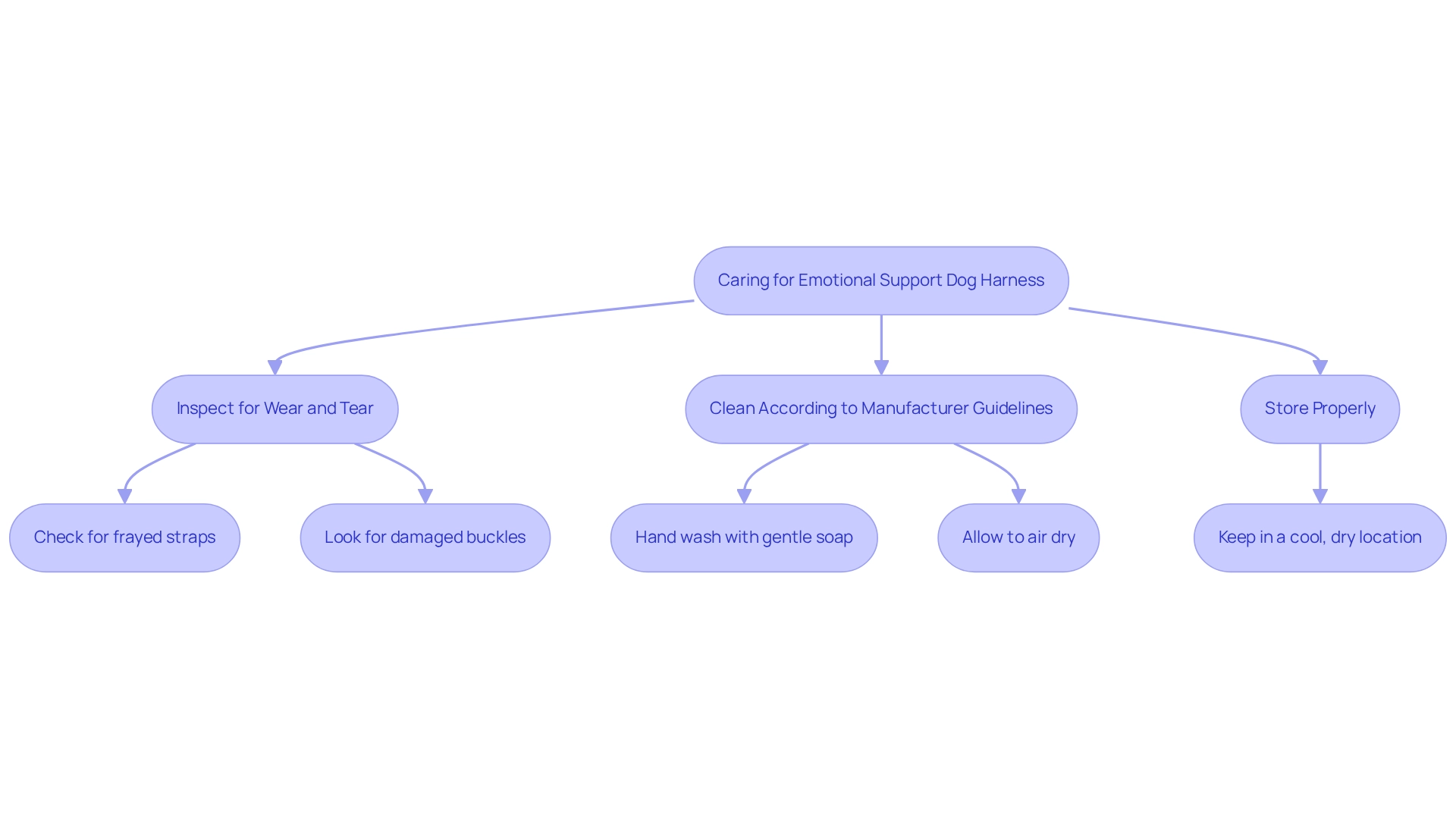
Conclusion
Emotional support animals provide essential companionship and comfort to many individuals, significantly enhancing their mental well-being. Caring for these animals is crucial, and this article has explored the efficient process for obtaining ESA letters, the benefits of specialized harnesses, and the important legal considerations for owners.
The right harness is vital for ensuring the safety and comfort of emotional support animals. These harnesses not only help with control during outings but also signal to the public that the animal is there to provide support. Have you considered how a properly fitted harness can make outings more enjoyable for both you and your companion? Understanding the different types of harnesses available and ensuring a proper fit is essential for effective integration into daily life.
While harnesses are not legally mandated, they can facilitate smoother interactions in public spaces and enhance the visibility of these important companions. Being aware of the legal landscape surrounding emotional support animals empowers owners to advocate for their rights while ensuring compliance with relevant regulations. How can knowing your rights help you feel more confident when navigating public spaces with your ESA?
In summary, prioritizing the care and appropriate equipment for emotional support animals fosters a healthier bond between owners and their pets. By focusing on the well-being of both parties and utilizing the right tools, individuals can cultivate a more fulfilling relationship with their emotional support companions. This ultimately leads to improved mental health and quality of life. Remember, you are not alone on this journey; support is available to help you and your beloved animal thrive together.
Frequently Asked Questions
What is the process for obtaining an ESA letter at Wellness Wag?
The process begins with a brief assessment to determine eligibility, followed by compassionate consultations with licensed physicians who assess your situation and provide tailored guidance. Once approved, you can expect to receive your official ESA letter within 24 hours.
How can an Emotional Support Animal (ESA) benefit mental health?
Having an emotional support animal can significantly reduce symptoms of mental health issues, enhancing both emotional resilience and physical well-being.
What is the purpose of an emotional support dog harness?
The emotional support dog harness enhances comfort and accessibility for both the pet and its owner by providing supportive restraints for better control during walks and reducing the risk of escape or harm.
Are there legal regulations regarding the use of emotional support dog harnesses?
While federal regulations do not mandate the use of emotional support dog harnesses, many specialists recommend them for easy identification. Understanding the legal landscape, such as the Fair Housing Act and the Air Carrier Access Act, is crucial for ESA owners.
What rights do ESA owners have under the Fair Housing Act?
The Fair Housing Act guarantees that individuals with therapy animals can reside in pet-restricted accommodations, which underscores the importance of possessing valid ESA letters.
Can ESAs travel on airlines?
Yes, the Air Carrier Access Act facilitates the travel of ESAs on airlines, provided that the appropriate paperwork is presented.
Why is it important to check state-specific regulations for ESAs?
State-specific regulations can vary significantly, and it’s essential for ESA owners to understand these laws to ensure compliance and protect their rights.
How does the use of an emotional support dog harness benefit ESA owners?
Using an emotional support dog harness can enhance the physical management of the animal and contribute to the psychological well-being of the owner by fostering a sense of safety and facilitating smoother interactions in public spaces.
Certify Your Emotional Support Animal Today

Why You Can Rely on Us?
At Wellness Wag, we believe your pet deserves care rooted in both science and compassion. Each article is carefully researched, written in clear language for pet owners, and then reviewed by qualified professionals to ensure the information is evidence-based, current, and practical for real-life care. Our goal is to help you feel confident in making informed decisions about your pet’s health and well-being.
Reviewed by
Angela Morris, MSW, LCSW
Angela is a licensed clinical social worker with 20 years of experience in patient advocacy and community mental health. She has assisted numerous clients with ESA evaluations and brings a deep understanding of disability accommodations, ensuring that all information is accurate, supportive, and practical.

Written by :
Lena Park
Last Updated :
July 10, 2025












